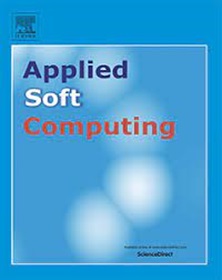基于TLBO的丘陵地区客户满意度多目标可持续多路径交付问题研究
IF 7.2
1区 计算机科学
Q1 COMPUTER SCIENCE, ARTIFICIAL INTELLIGENCE
引用次数: 0
摘要
通过公路运输的物流产生了大量的碳排放。在商业中,及时交货即顾客满意是很重要的。在此基础上,提出了一种具有客户满意度的丘陵地区可持续多目标三维交付问题(SMO3DDPwCS),以同时最小化总CE和客户不满意度(CDS)。在这里,一个供应商的车辆从仓库出发,货物与零售商的需求相等,根据零售商的订单在他们的首选时间内分配给零售商,然后返回。零售商的商店和仓库通过多条丘陵轨道相连,这些轨道有上下斜坡,容易发生滑坡。小心驾驶通过这些轨道产生额外的CE和cd。SMO3DDPwCS采用改进的MOTLBO (mMOTLBO)算法求解。该算法在教学阶段和学习阶段都引入了自主学习的概念,引入了创新的升级策略,采用了基于群体的学习方法。在标准TSPLIB实例上使用mMOTLBO执行一些统计测试。mMOTLBO对NSGA-II和MOEA/D的效率进行了验证。使用TOPSIS对Pareto front的多个解决方案进行排名。制定了一些管理决策。提出了SMO3DDPwCS在丘陵地区的最优路径方案,其总CE为31%,总CDS为8%,优于单路径方案。在大多数情况下,对于目标的Pareto前沿,mMOTLBO算法表现出优于其他算法的优势。在基准实例上,mMOTLBO表现出优于NSGA-II和MOEA/D的优势,在IGD和GD方面分别提高了0.11和4.12。本文章由计算机程序翻译,如有差异,请以英文原文为准。

A multi-objective sustainable multipath delivery problem in hilly regions with customer-satisfaction using TLBO
Logistic delivery through road contributes substantial carbon emission (CE). In business, timely goods delivery i.e. customer satisfaction, is important. With these facts, a sustainable multi-objective 3D delivery problem with customer satisfaction (SMO3DDPwCS) in a hilly region (HR) is developed to minimize total CE and customer dissatisfaction (CDS) simultaneously. Here, one supplier’s vehicle starts from the depot with goods equal to retailers’ demands, distributes among the retailers as per their orders within their preferred times, and comes back. The retailers’ shops and depot are connected through multiple hilly tracks, which have up and down slopes and are susceptible to landslide. The cautious driving through these tracks produces extra CE and CDS. The SMO3DDPwCS is solved by a modified MOTLBO (mMOTLBO) algorithm. This algorithm incorporates self-learning concepts after both the teaching and learning phases, introduces innovative upgrading strategies, and employs a group-based learning approach. Some statistical tests are performed using mMOTLBO on the standard TSPLIB instances. The efficiency of mMOTLBO is established against NSGA-II and MOEA/D. Multiple solutions in Pareto front are ranked using TOPSIS. Some managerial decisions are drawn. The optimum routing plan for SMO3DDPwCS in a hilly region is presented and gives better results (31% total CE and 8% total CDS) than the single path formulation. mMOTLBO showed superiority over other algorithms in most cases concerning the Pareto front for the objectives. On the benchmark instances, mMOTLBO demonstrated its superiority by outperforming NSGA-II and MOEA/D, showing improvements of 0.11 in IGD and 4.12 in GD.
求助全文
通过发布文献求助,成功后即可免费获取论文全文。
去求助
来源期刊

Applied Soft Computing
工程技术-计算机:跨学科应用
CiteScore
15.80
自引率
6.90%
发文量
874
审稿时长
10.9 months
期刊介绍:
Applied Soft Computing is an international journal promoting an integrated view of soft computing to solve real life problems.The focus is to publish the highest quality research in application and convergence of the areas of Fuzzy Logic, Neural Networks, Evolutionary Computing, Rough Sets and other similar techniques to address real world complexities.
Applied Soft Computing is a rolling publication: articles are published as soon as the editor-in-chief has accepted them. Therefore, the web site will continuously be updated with new articles and the publication time will be short.
 求助内容:
求助内容: 应助结果提醒方式:
应助结果提醒方式:


